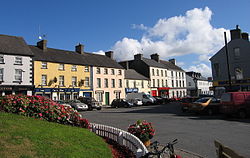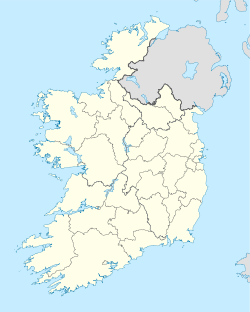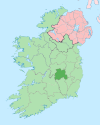- Mountrath
-
Mountrath
Maighean Rátha— Town — Location in Ireland Coordinates: 53°00′N 7°28′W / 53°N 7.467°WCoordinates: 53°00′N 7°28′W / 53°N 7.467°W Country Ireland Province Leinster County Laois Population (2006) - Urban 1,465 Time zone WET (UTC+0) - Summer (DST) IST (WEST) (UTC-1) Irish Grid Reference Mountrath (Irish: Maighean Rátha) is a small town in County Laois, Ireland. Bypassed by the M7 motorway in 2010, the town lies on the R445 midway between Dublin and Limerick, exactly 96.5 km (60 mi) from both cities.
In 2006 it had a population of 1,435. The river that flows through the town is called the Whitehorse and gets it name from the white colouring that was present in its water from the whiskey distillery that used to be in the centre of the town.
Contents
Name
Mountrath is an anglicisation of the Irish name Maighean Rátha, which roughly means "precinct of the ringfort". Older anglicisations include Moyenrath, Moynrath, Monrath, Moyenrae, Moynrae and Moenra.[1]
Places of interest
Near Mountrath on the R445 towards Portlaoise is a shapeless old Wish Tree in the form of a Sycamore tree called St Fintan's Well. The original well was filled in, but the water re-appeared in the centre of the tree. Hundreds of Irish pennies have been beaten into the bark as good luck offerings, until they eventually killed the tree.[2] and go to Mountrath Service Station for refreshments.
History
The important Synod of Ráth Breasail was held near Mountrath in 1111.
In the beginning of the 17th century, the lands around Mountrath became the property of Charles Coote. Despite the wild surrounding country, which was covered with woodlands, he laid the foundation of the present town. In 1628 Coote obtained for the inhabitants a grant of two weekly markets and two fairs, and established a very extensive linen and fustian manufactory. In the year 1641, as a Royalist supporter, much of his property was destroyed during the Irish Confederacy in the War of the Three Kingdoms.
His son Sam Coote regained the castle and estate of Mountrath, along with other properties and following the Restoration, was created Earl of Mountrath. This title was extant until the death of Charles Henry, the 7th Earl, in 1802, when became extinct. Newpark, adjoining the town, was the residence of the Earl of Mountrath. In 1831 the town contained 429 houses; iron was made and wrought here till the neighbouring woods were consumed for charcoal fuel. The Post Chaise Companion, published in 1805, states that "Near Mountrath is an extensive bank containing, or rather, formed of excellent iron ore, within a few metres of the surface; here an iron and metal foundry has been established and wrought some years since with great success; but at present, from the scarcity of charcoal, on the destruction of the neighbouring woods, the furnaces are seldom employed; it is much to be regretted that such a valuable manufacture should be discontinued on the above account, as the country abounds with bogs, and charred turf might probably be substituted in the place of charcoal for most purposes."
Samuel Lewis in his Topographical Dictionary of Ireland 1837, states:
"An extensive factory for spinning and weaving cotton is carried on by Mr. Greenham, who employs 150 persons in the spinning mills, and about 500 in weaving calicoes at their own houses; the average quantity manufactured is from 200 to 250 pieces weekly. Stuff-weaving is also carried on extensively; there is a large brewery and malting establishment, and an extensive oil mill; and the inhabitants carry on a very extensive country trade."
In the latter portion of the eighteenth and early nineteenth twentieth century, the Orange Order was strong in the town of Mountrath and surrounding townships. Older leases granted on the Castlecoote estate, on which the town was built, were written in strict accordance with the Penal Laws, and contained a clause prohibiting the letting, selling, or bestowal of ground for the purpose of erecting a Roman Catholic Church. In consequence of this prohibition, the place of worship used by local Catholics stood upon a sand-bank beside a tributary of the River Nore called 'The Brook".
In 1794, Dr. Delany, Bishop of Kildare and Leighlin proposed to build a parish church. Lord Castlecoote was publicly opposed to the proposal but the political climate of toleration that followed the Relief Act of 1793 encouraged the bishop. He made application for a site to Mr.Hawkesworth, agent to Lord Castlecoote. This gentleman found Dr. Delany a suitable plot from his own landholdings and shortly after, through his influence with the proprietor, procured a perpetual peppercorn lease as a site for a parish church. Building commenced about in 1795.
On the 18 April 1809, the Convent of St. Brigid, at Mountrath, was founded by three sisters from the mother house at Tullow. Soon after, the Monastery of St. Patrick was established. Both convent and monastery communities were employed in the education of Roman Catholic pupils.
A new church was completed in 1867. The exertions made by Brother John, of the Mountrath Monastery, contributed to the success of the undertaking. This zealous religious travelled through a great portion of North America, Australia and New Zealand, soliciting funds which enabled him to transmit the large sum of £4,000, over and above his expenses. The new church of Mountrath is one of the finer parochial churches in the Diocese of Kildare and Leighlin. Several priests were interred in the former church. Through the care of a recent pastor, the inscribed tablets which marked their last resting places, have been installed in the wall of the new church.
A painted window, and a marble altar have been erected to honour the former pastor, James Dunne. Another marble altar has been raised as a memorial of former pastor Andrew M'Donald. The parochial church plate includes a chalice, the gift of Bishop Delany, bearing the following inscription:- " In honorem Sanctissimae Sacramenti Eucharistiae suis impensis hunc calicem fieri curavit Reverendissimus Daniel Delany, epus. Kilds. et Leighs. Donoque dedit parochiae de Mountrath,
Education
Secondary St Aengus and The Brigidine Convent in Mountrath both closed in May/June 2009. In September 2009 they amalgamated with nearby Patrician College Ballyfin to form Mountrath Community School
Primary schools there are three primary in mountrath
St.Fintan's B.N.S
Scoil Bhríde girls' school
Clonenagh primary school
References
- ^ Placenames Database of Ireland (see archival records)
- ^ Wilkinson, Gerald (1976). Trees in the Wild. Book Club Associates. P.108.
A Topographical Dictionary of Ireland Samuel Lewis (publisher) 1837.
External links
Places in County Laois County town: Portlaoise Towns Abbeyleix · Durrow · Mountmellick · Mountrath · Portarlington · Portlaoise · Rathdowney · Stradbally
Villages and
TownlandsAghaboe · Arless · Ballacolla · Ballaghmore · Ballickmoyler · Ballinakill · Ballybrittas · Ballybrophy · Ballyfin · Ballyhide · Ballyhuppahane · Ballylinan · Ballyroan · Barrowhouse village · Borris-in-Ossory · Castletown · Clonaghadoo · Clonaslee · Crettyard · Cullohill · Donaghmore · Emo · Errill · Jamestown · Kilbricken · Killeshin · New Inn · Newtown · Raheen · Rosenallis · Shanahoe · Sletty · Spink · The Swan · Timahoe · Vicarstown
Landforms Arderin · Baunreaghcong · Bog of Allen · Castlecomer Plateau · Castleconor · Garraunbaun · Slieve Bloom Mountains
List of townlands in County Laois · Category:Mountains and hills of County Laois · Category:Rivers of County Laois · Category:Geography of County Laois Categories:- Untranslated Irish place names
- Towns and villages in County Laois
- Articles on towns and villages in Ireland possibly missing Irish place names
- Townlands of County Laois
Wikimedia Foundation. 2010.



